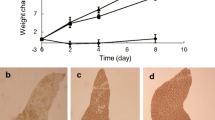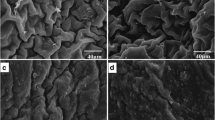Abstract
Ulva prolifera is a marine macroalga with medicinal and edible potential, but Ulva is also the causative genus behind undesirable green tides which cause serious adverse effects on coastal ecology and the environment. A strong relationship exists between U. prolifera blooms and ambient temperature; however, the metabolic mechanism involved is still largely unclear. To assess the metabolic changes in U. prolifera in response to temperature stress, the metabolic profile of U. prolifera was analyzed by gas chromatography-mass spectrometry (GC-MS), and a total of 67 compounds were identified. The metabolic profiles of U. prolifera cultured under high- and low-temperature treatments were significantly different from each other, as revealed by principal component analysis (PCA) and orthogonal partial least squares discriminant analysis (OPLS-DA). Twenty-four metabolites, including sugars and amino acids, accumulated under high-temperature stress (HTS) compared with those in the control group, while the levels of 9 and 6 metabolites significantly increased and decreased, respectively, under low-temperature stress (LTS). The galactose, starch/sucrose, and alanine/aspartate/glutamate metabolic pathways were changed under HTS, while the tricarboxylic acid cycle and starch/sucrose, tyrosine, and arginine/proline metabolism were involved in the LTS response. In addition, the metabolic network involved in temperature stress was further constructed. To the best of our knowledge, this is the first study to reveal metabolic shifts in U. prolifera in response to temperature stress and its results provide important insights into the mechanisms involved in the tolerance of U. prolifera to temperature stress and a basis for further research on green tide blooms.






Similar content being viewed by others
References
Arbona V, Manzi M, Cd O, Gómezcadenas A (2013) Metabolomics as a tool to investigate abiotic stress tolerance in plants. Int J Mol Sci 14:4885–4991
Bascomb NF, Schmidt RR (1987) Purification and partial kinetic and physical characterization of two chloroplast-localized NADP-specific glutamate dehydrogenase isozymes and their preferential accumulation in Chlorella sorokiniana cells cultured at low or high ammonium levels. Plant Physiol 83:75–84
Bita CE, Gerats T (2013) Plant tolerance to high temperature in a changing environment: scientific fundamentals and production of heat stress-tolerant crops. Front Plant Sci 4:1–18
Chao Z (2014) Purification and composition analysis of polysaccharide from edible seaweed Enteromorpha prolifera and polysaccharides depolymerized enzymes from microorganisms. Res J Biotechnol 9:30–36
Chen W, Li P (2002) Membrane stabilization by abscisic acid under cold aids proline in alleviating chilling injury in maize (Zea mays L.) cultured cells. Plant Cell Environ 25:955–962
Cui J, Zhang J, Huo Y (2015a) Adaptability of free-floating green tide algae in the Yellow Sea to variable temperature and light intensity. Mar Pollut Bull 101:660–666
Cui W, Fang Q, Zhang Y, Cao H, Zhang J, Wang R, Shen W (2015b) Methane-rich water induces cucumber adventitious rooting through heme oxygenase1/carbon monoxide and Ca2+ pathways. Plant Cell Rep 34:435–445
Diamant S, Eliahu N, Rosenthal D, Goloubinoff P (2001) Chemical chaperones regulate molecular chaperones in vitro and in cells under combined salt and heat stresses. J Biol Chem 276:39586–39591
Dittami SM, Gravot A, Goulitquer S, Rousvoal S, Peters AF, Bouchereau A (2012) Towards deciphering dynamic changes and evolutionary mechanisms involved in the adaptation to low salinities in Ectocarpus (brown algae). Plant J Cell Mol Biol 71:366–377
Edwards DM, Reed RH, Chudek JA, Foster R, Stewart WDP (1987) Organic solute accumulation in osmotically-stressed Enteromorpha intestinalis. Mar Biotechnol 95:583–592
Eggert A (2012) Seaweed responses to temperature. In: Wiencke C, Bischof K (eds) Seaweed biology: novel insights into ecophysiology, ecology and utilization. Springer, Berlin, pp 47–66
Fan X, Xu D, Wang Y, Zhang X, Cao S, Mou S, Ye N (2014) The effect of nutrient concentrations, nutrient ratios and temperature on photosynthesis and nutrient uptake by Ulva prolifera: implications for the explosion in green tides. J Appl Phycol 26:537–544
Fiehn O (2002) Metabolomics—the link between genotypes and phenotypes. Plant Mol Biol 48:155–171
Gupta V, Thakur RS, Baghel RS, Reddy CRK, Jha B (2014) Seaweed metabolomics: new facet of functional genomics. Adv Bot Res 71:31–52
Guy C, Kaplan F, Kopka J, Selbig J, Hincha DK (2008) Metabolomics of temperature stress. Physiol Plant 132:220–235
Haxen PG, Lewis OAM (1981) Nitrate assimilation in the marine kelp Macrocystis anguatifolia (Phaeophyceae). Bot Mar 24:631–635
Hiraoka M (2003) Different life histories of Enteromorpha prolifera (Ulvales, Chlorophyta) from four rivers on Shikoku Island, Japan. Phycologia 42:275–284
Hong J, Yang L, Zhang D, Shi J (2016) Plant metabolomics: an indispensable system biology tool for plant science. Int J Mol Sci 17:1–16
Inokuchi R, Itagaki T, Wiskich JT, Nakayama K, Okada M (1997) An NADP-glutamate dehydrogenase from the green alga Bryopsis maxima: purification and properties. Plant Cell Physiol 38:327–335
Kakinuma M, Coury DA, Kuno Y, Itoh S, Kozawa Y, Inagaki E, Yoshiura Y, Amano H (2006) Physiological and biochemical responses to thermal and salinity stresses in a sterile mutant of Ulva pertusa (Ulvales, Chlorophyta). Mar Biol 149:97–106
Kumar M, Kuzhiumparambil U, Pernice M, Jiang Z, Ralph PJ (2016) Metabolomics: an emerging frontier of systems biology in marine macrophytes. Algal Res 16:76–92
Kumar M, Kuzhiumparambil U, Ralph P, Contreras-Porcia L (2017) Polyamines: stress metabolite in marine macrophytes. In: Madamwar D, Pandey A (eds) Algal green chemistry, recent progress in biotechnology. Elsevier, Amsterdam, pp 243–255
Li X, Han Z, Liu X, Jin S, Liu Y (2016) A study of the relationship between the processes of Enteromorpha and Sargassum and sea surface temperature. Trans Oceanol Limnol 5:126–130
Li YH, Wang D, Xu XT, Gao XX, Sun X, Xu NJ (2017) Physiological responses of a green algae (Ulva prolifera) exposed to simulated acid rain and decreased salinity. Phytosynthetica 55:623–629
Lin A, Shen S, Wang J, Yan B (2008) Reproduction diversity of Enteromorpha prolifera. J Integr Plant Biol 50:622–629
Linting M, Meulman JJ (2011) Statistical significance of the contribution of variables to the PCA solution: an alternative permutation strategy. Psychometrika 76:440–460
Lisec J, Schauer N, Kopka J, Willmitzer L, Fernie AR (2006) Gas chromatography mass spectrometry-based metabolite profiling in plants. Nat Protoc 1:387–395
Liu Y, Xu J, Li X, Yao D, Liu Z (2014) The effects of different proliferative ways for the green tide alga Ulva prolifera on their growth and photophysiological performances. J Fish China 38:691–696
Liu Q, Yu RC, Yan T, Zhang QC, Zhou MJ (2015) Laboratory study on the life history of bloom-forming Ulva prolifera in the Yellow Sea. Estuar Coast Shelf Sci 163:82–88
Luo MB, Liu F, Xu ZL (2012) Growth and nutrient uptake capacity of two co-occurring species, Ulva prolifera and Ulva linza. Aquat Bot 100:18–24
Mishra D, Shekhar S, Agrawal L, Chakraborty S, Chakraborty N (2017) Cultivar-specific high temperature stress responses in bread wheat (Triticum aestivum (L.)) associated with physicochemical traits and defense pathways. Food Chem 221:1077–1087
Muñoz-Blanco J, Moyano E, Cárdenas J (1989) Glutamate dehydrogenase isozymes of Chlamydomonas reinhardtii. FEMS Microbiol Lett 61:315–318
Nylund GM, Weinberger F, Rempt M, Pohnert G (2011) Metabolomic assessment of induced and activated chemical defence in the invasive red alga Gracilaria vermiculophylla. PLoS One 6:e29359
Oaks A (1994) Primary nitrogen assimilation in higher plants and its regulation. Can J Bot 72:739–750
Planchet E, Limami AM (2015) Amino acid synthesis under abiotic stress. In: D’Mello JPF (ed) Amino acids in higher plants. CBA, Wallingford, pp 262–276
Robinson SA, Slade AP, Fox GG, Phillips R, Ratcliffe RG, Stewart GR (1991) The role of glutamate dehydrogenase in plant nitrogen metabolism. Plant Physiol 95:509–516
Ruan YL, Jin Y, Yang YJ, Li GJ, Boyer JS (2010) Sugar input, metabolism, and signaling mediated by invertase: roles in development, yield potential, and response to drought and heat. Mol Plant 3:942–955
Sato M, Sato Y, Tsuchiya Y (1984) Glutamate dehydrogenase of Porphyra yezoensis. Hydrobiologia 116/117:584–587
Sieciechowicz KA, Joy KW, Ireland RJ (1988) The metabolism of asparagine in plants. Phytochemistry 27:663–671
Sousa AI, Martins I, Lillebø AI, Flindt MR, Pardal MA (2007) Influence of salinity, nutrients and light on the germination and growth of Enteromorpha sp. spores. J Exp Mar Biol Ecol 341:142–150
Srivastava HS, Singh RP (1987) Role and regulation of L-glutamate dehydrogenase activity in higher plants. Phytochemistry 26:597–610
Szabados L, Savouré A (2010) Proline: a multifunctional amino acid. Trends Plant Sci 15:89–97
Thakur P, Kumar S, Malik JA, Berger JD, Nayyar H (2010) Cold stress effects on reproductive development in grain crops: an overview. Environ Exp Bot 67:429–443
Theocharis A, Clément C, Barka EA (2012) Physiological and molecular changes in plants grown at low temperatures. Planta 235:1091–1105
Wang J, Yan B, Lin A, Hu J, Shen S (2007) Ecological factor research on the growth and induction of spores release in Enteromorpha prolifera (Chlorophyta). Mar Sci Bull (Chin Ed) 26:60–65
Wang Y, Miao J, Jiang Y, Liu F, Zheng Z, Li G (2016) Roles of proline and soluble sugar in the cold-adaptation of Antarctic ice microalgae. Biotechnol Bull 32:198–202
Webb WL, Newton M, Starr D (1974) Carbon dioxide exchange of Alnus rubra: a mathematical model. Oecologia 17:281–291
Xia J, Sinelnikov IV, Han B, Wishart DS (2015) MetaboAnalyst 3.0—making metabolomics more meaningful. Nucleic Acids Res 43:W251–W257
Zhang J, Huo Y, Yu K, Chen Q, He Q, Han W, Chen L, Cao J, Shi D, He P (2013a) Growth characteristics and reproductive capability of green tide algae in Rudong coast, China. J Appl Phycol 25:795–803
Zhang Z, Wang X, Zhao M, Yu S, Qi H (2013b) The immunological and antioxidant activities of polysaccharides extracted from Enteromorpha linza. Int J Biol Macromol 57:45–49
Funding
This study was financially supported by the National Natural Science Foundation of China (41276122; 41606129). This research was also sponsored by the K.C.Wong Magna Fund in Ningbo University.
Author information
Authors and Affiliations
Corresponding author
Electronic supplementary material
Table S1
The fitted parameters from the rapid light curves of U. prolifera at LTS, Control and HTS. (DOCX 14 kb)
Rights and permissions
About this article
Cite this article
He, Y., Hu, C., Wang, Y. et al. The metabolic survival strategy of marine macroalga Ulva prolifera under temperature stress. J Appl Phycol 30, 3611–3621 (2018). https://doi.org/10.1007/s10811-018-1493-3
Received:
Revised:
Accepted:
Published:
Issue Date:
DOI: https://doi.org/10.1007/s10811-018-1493-3




